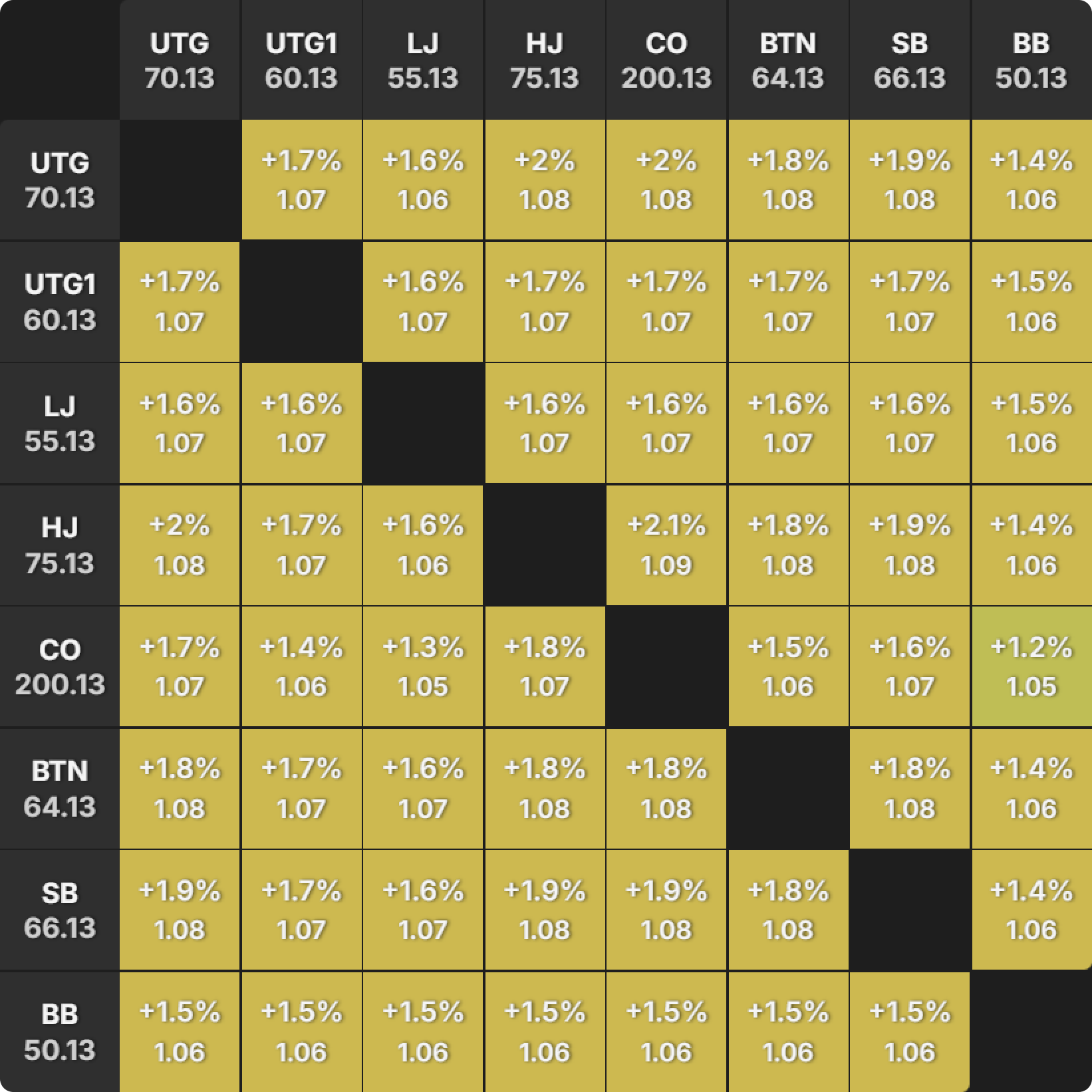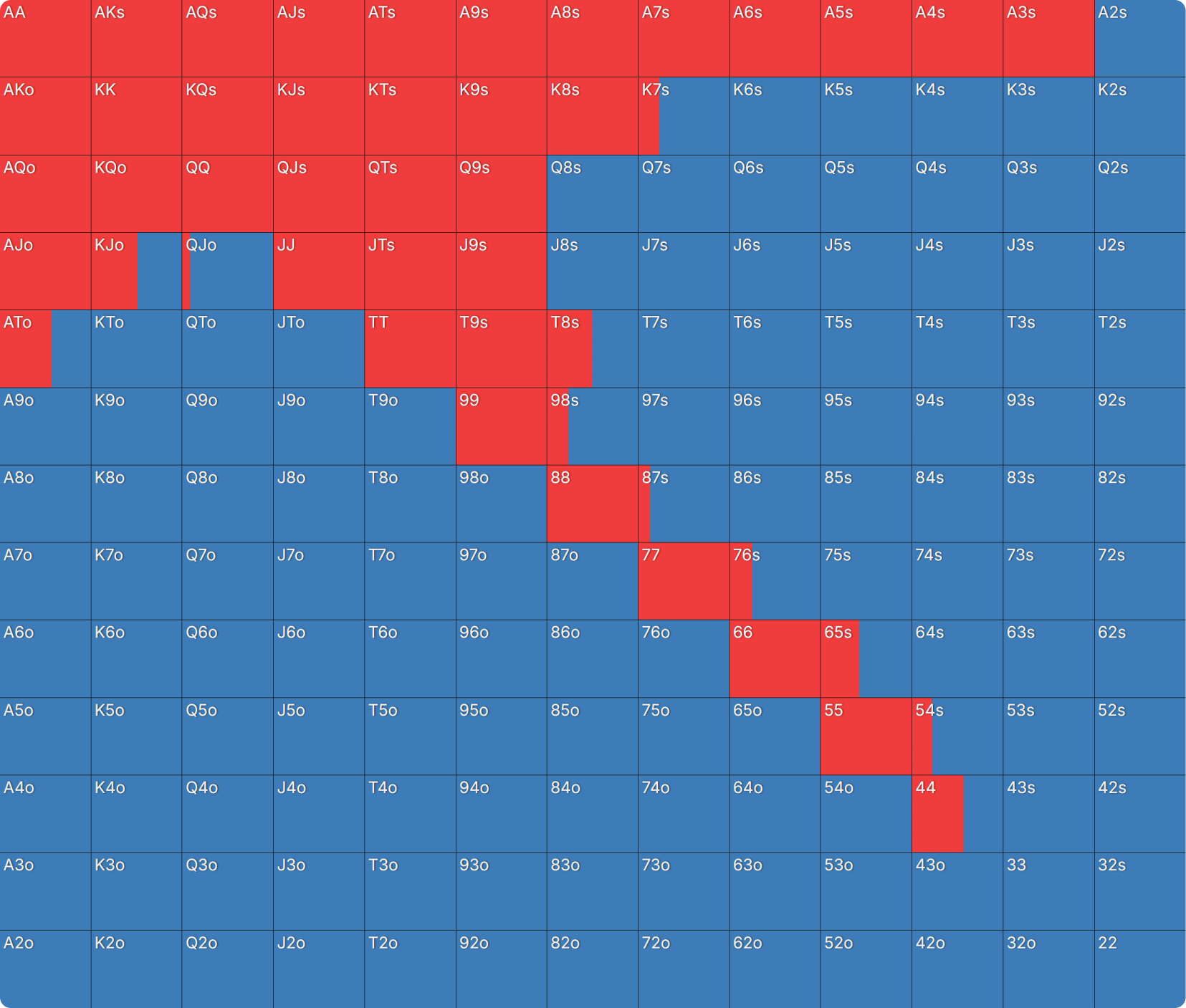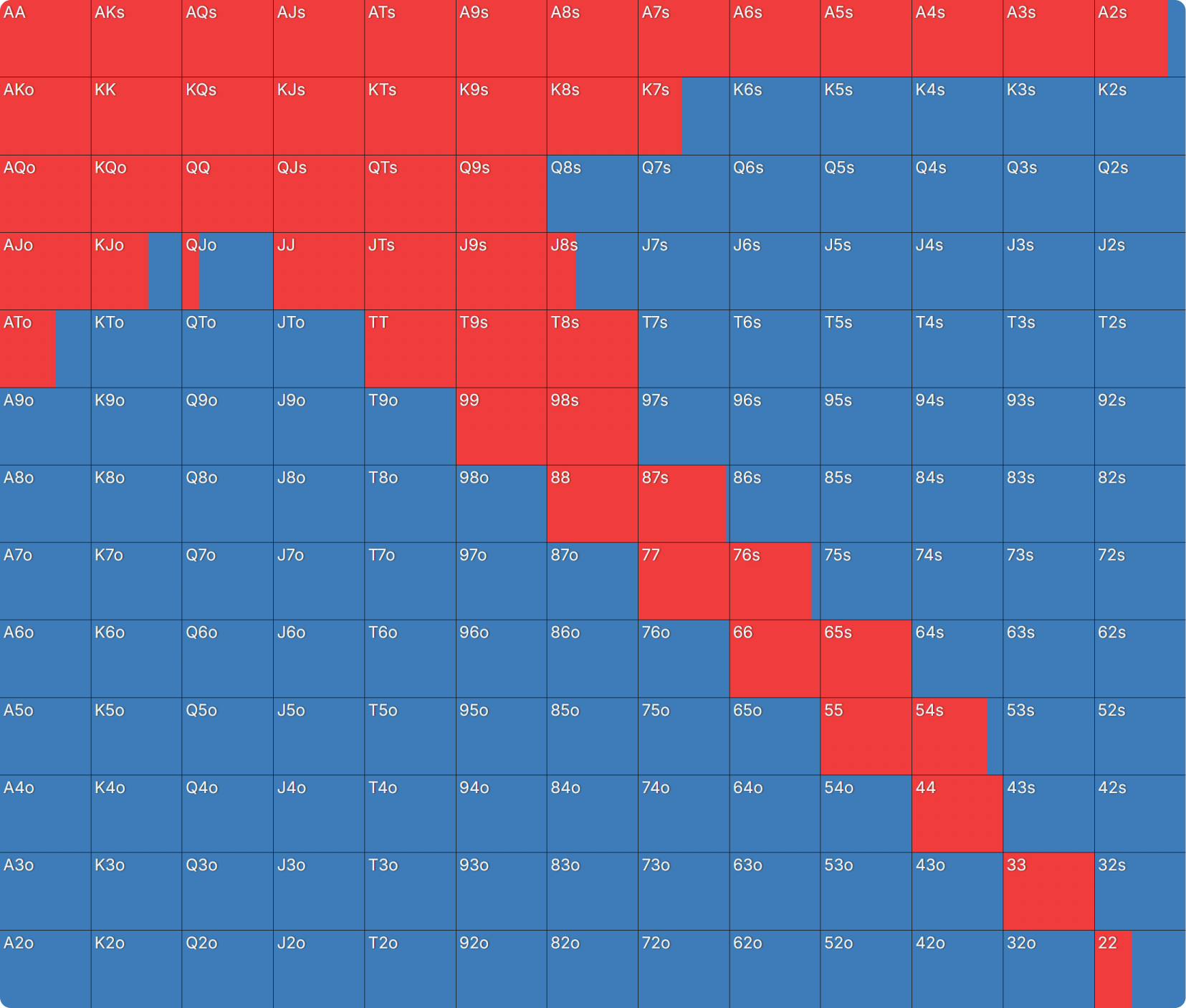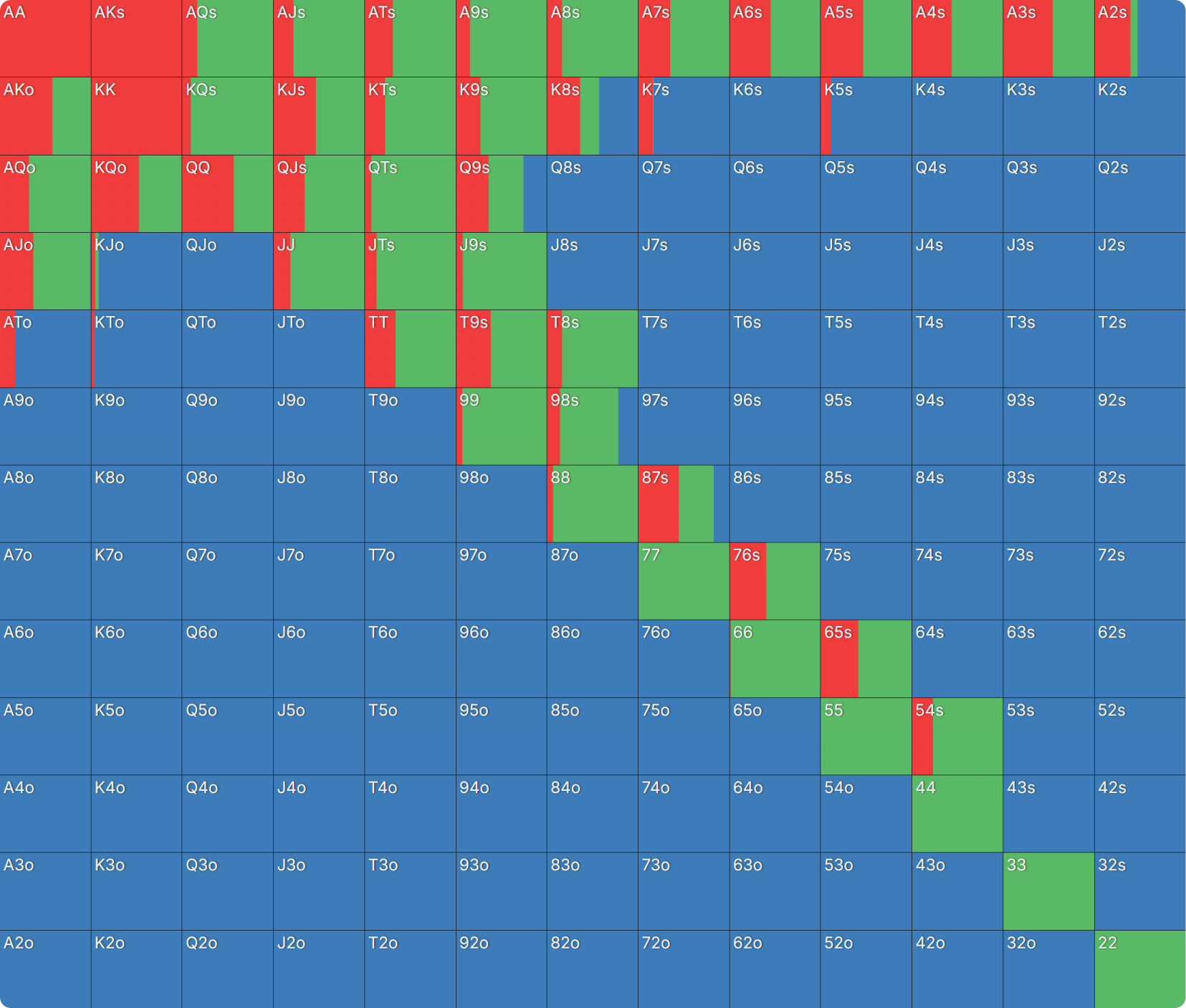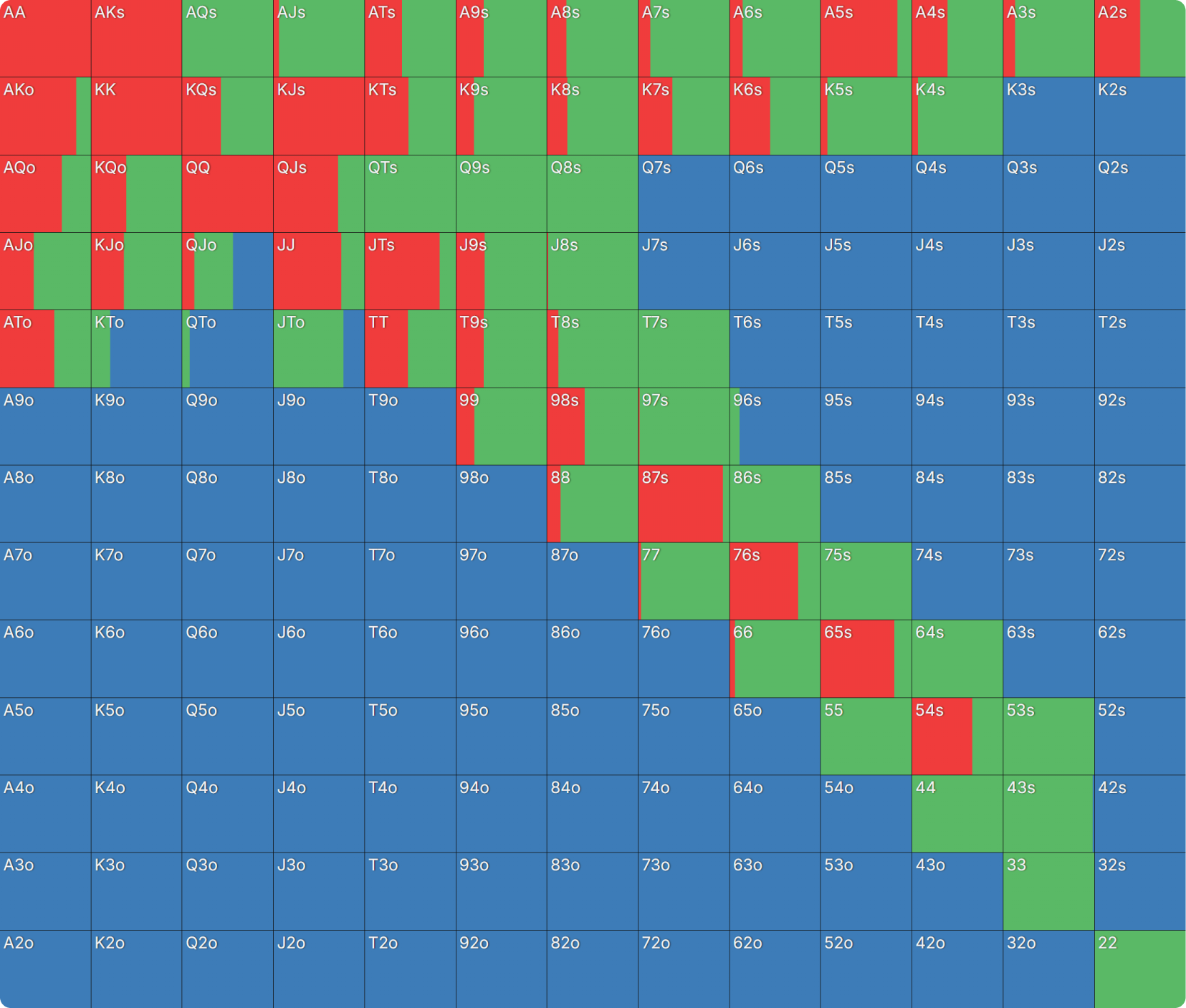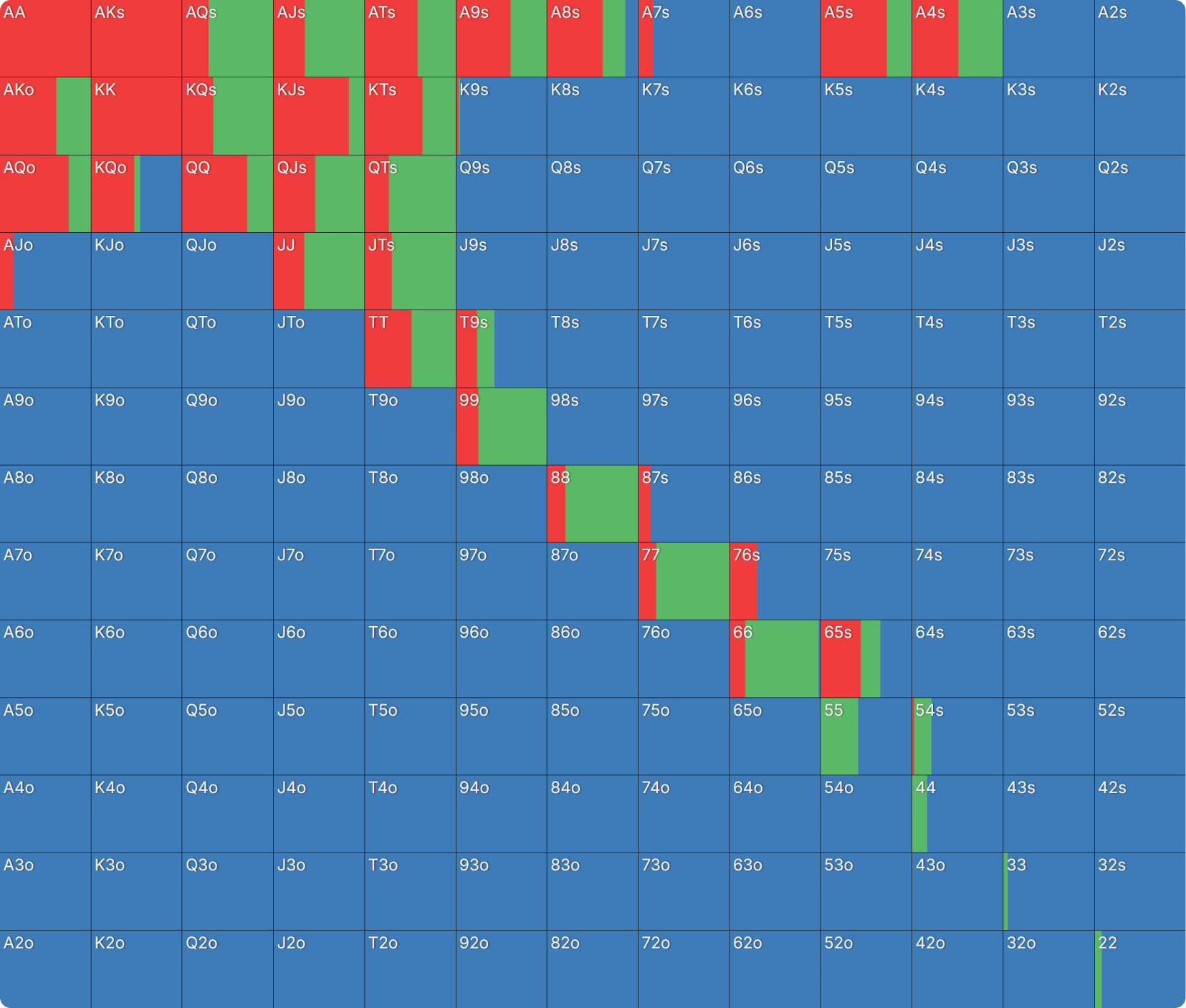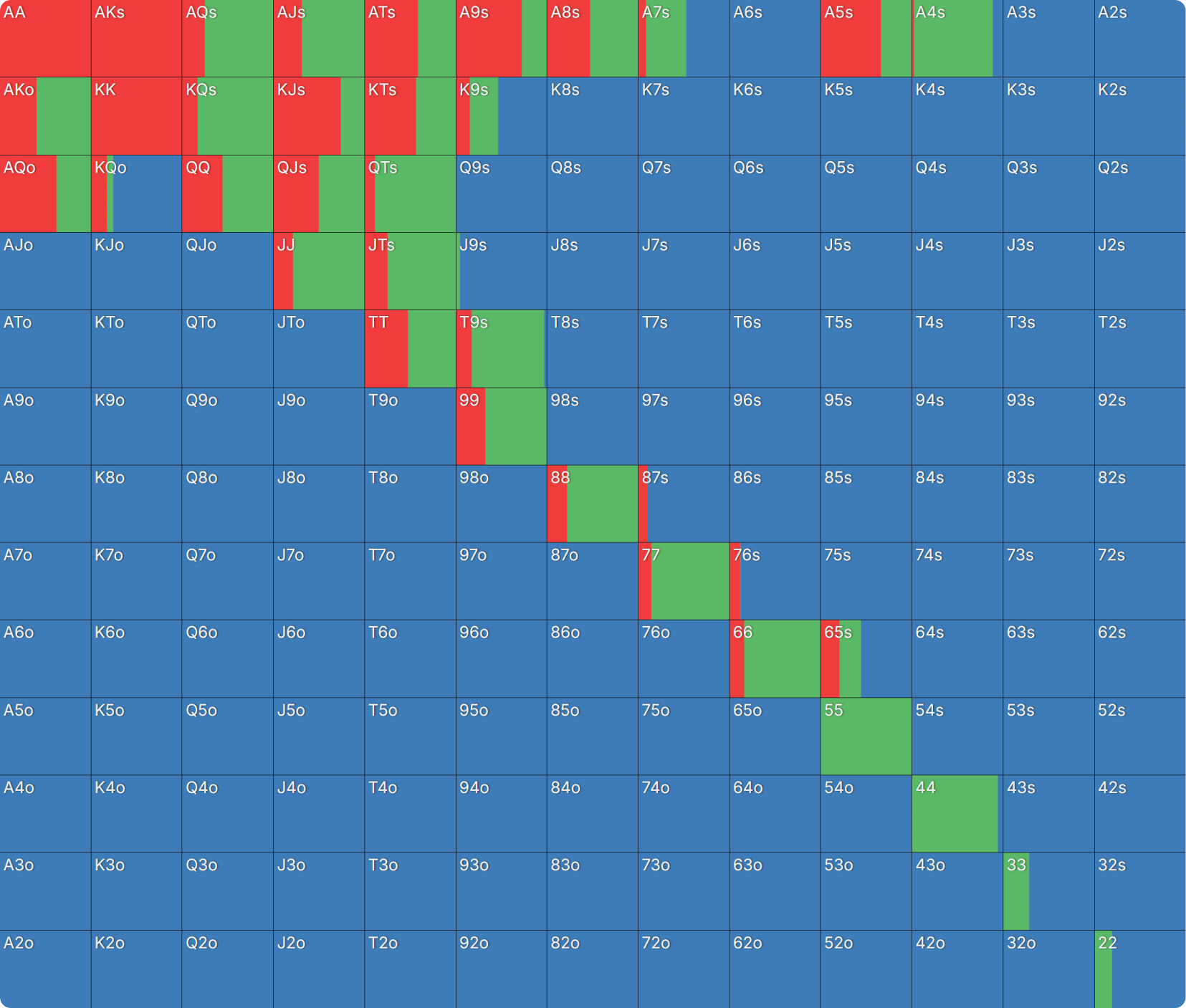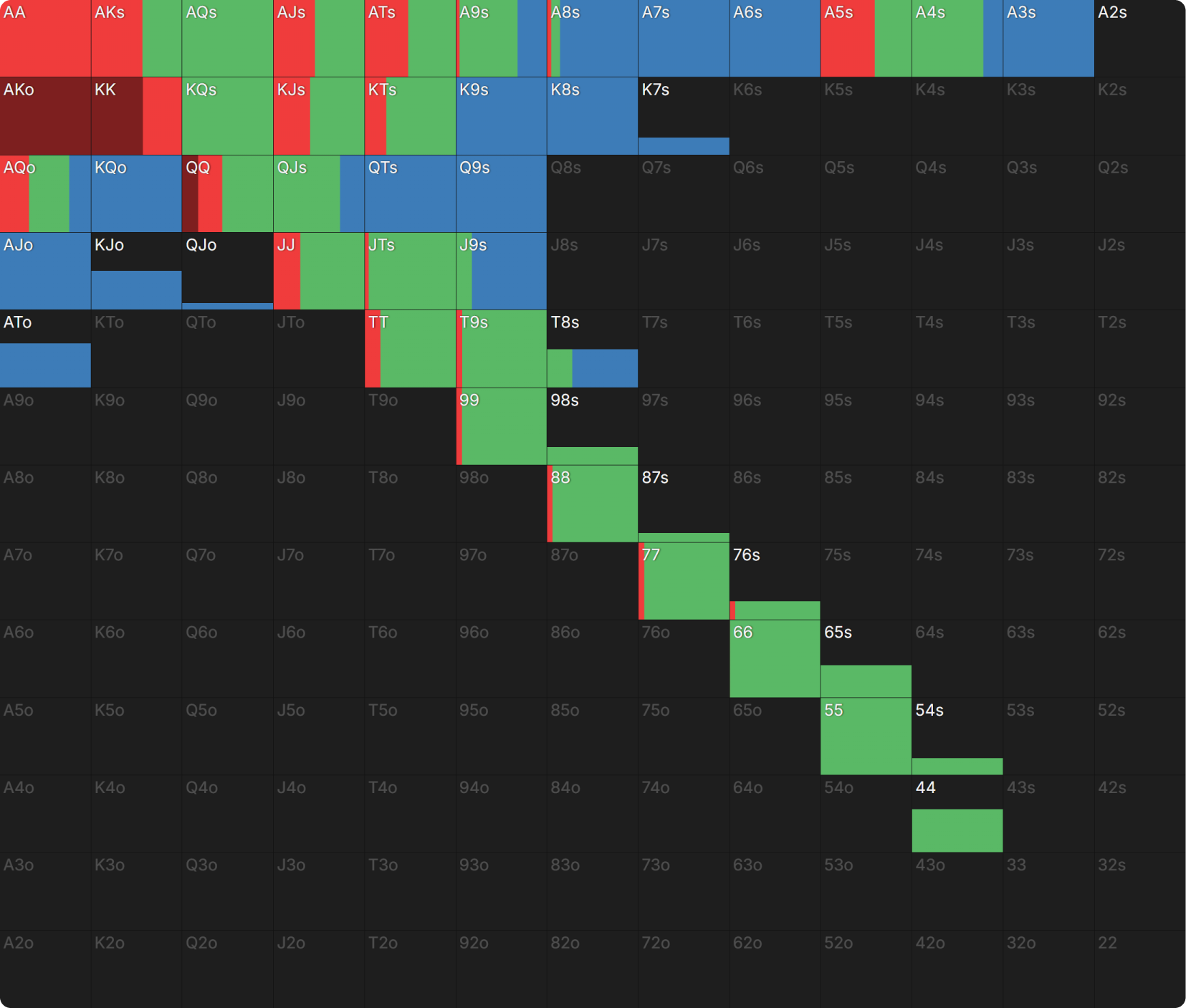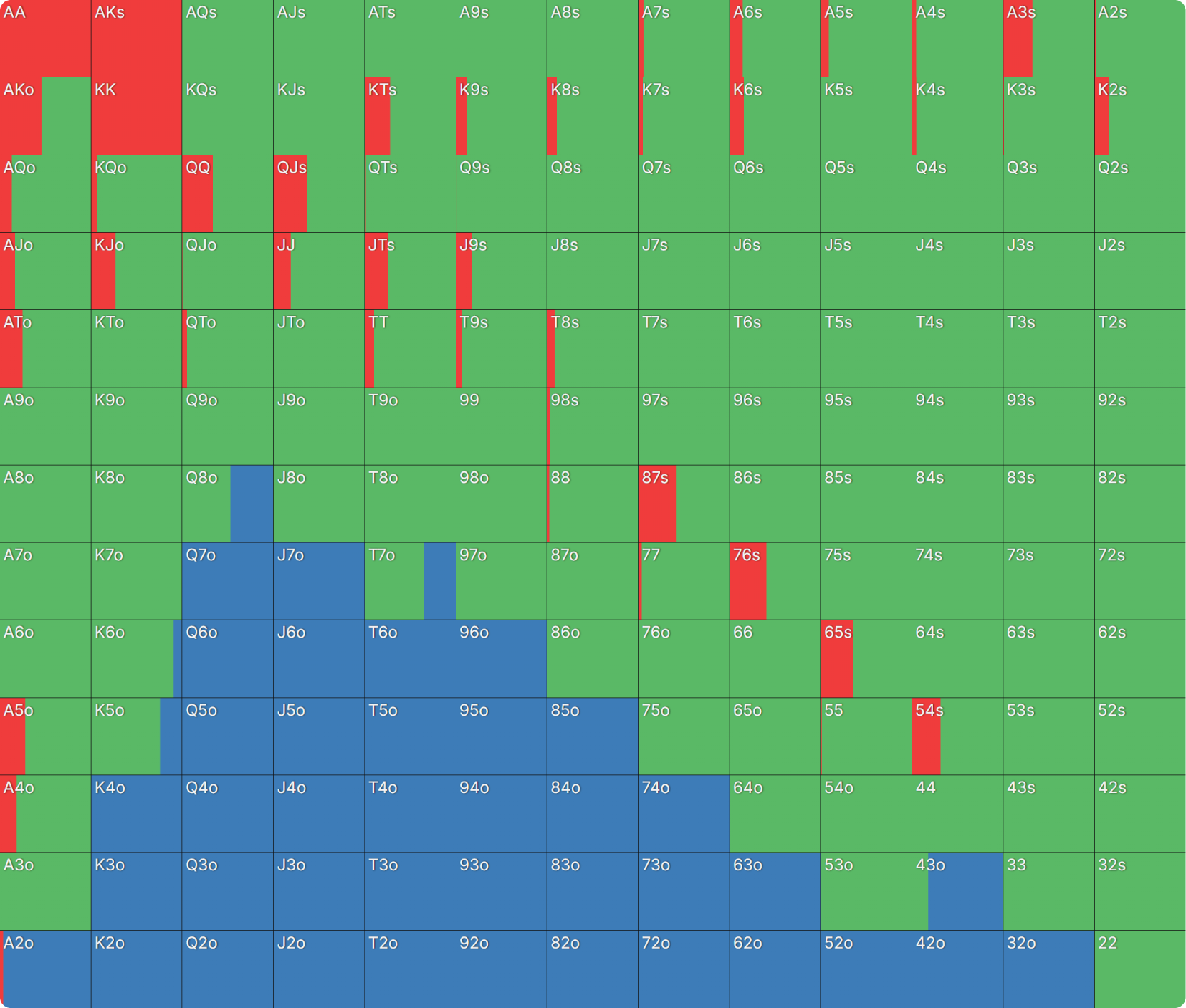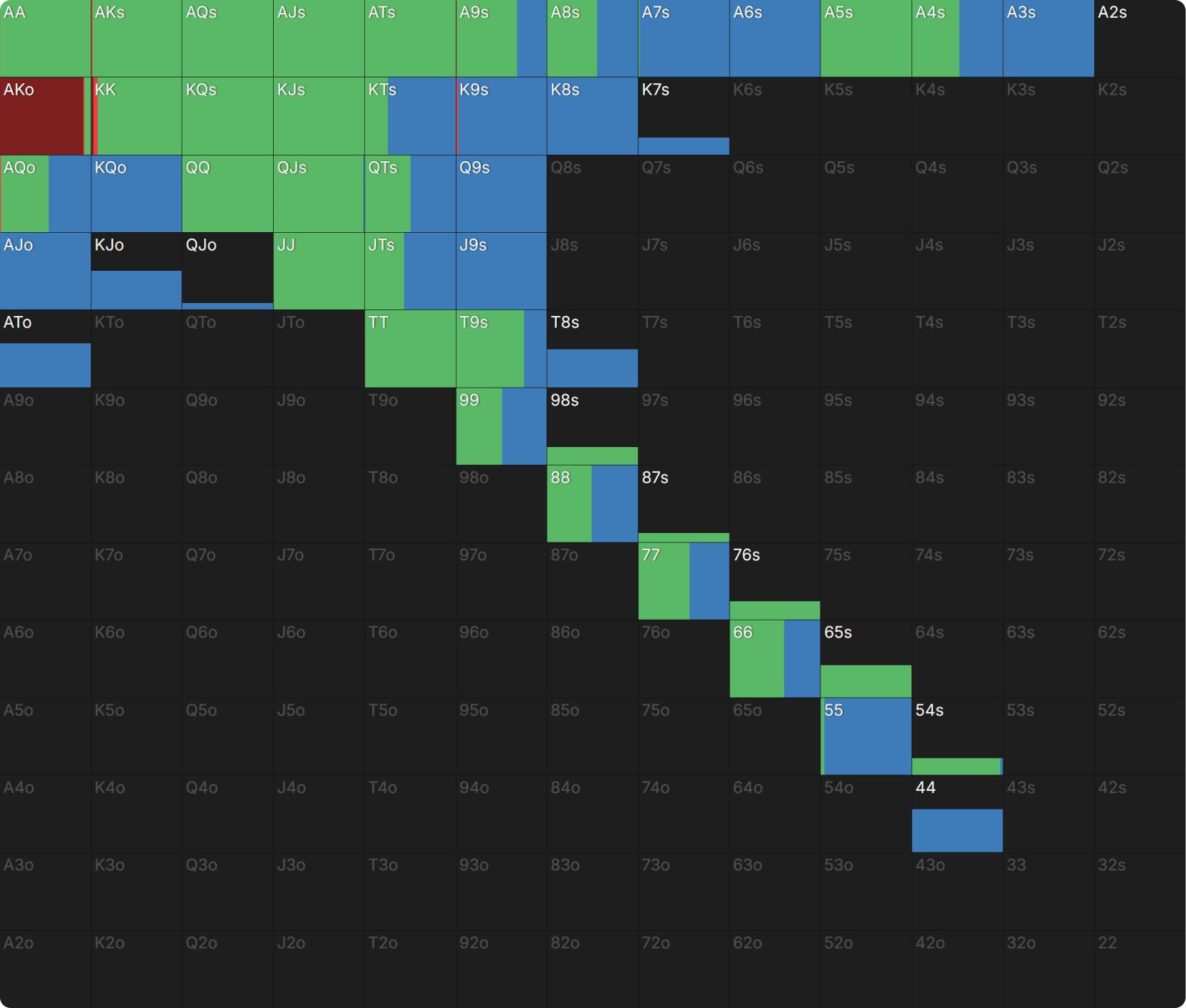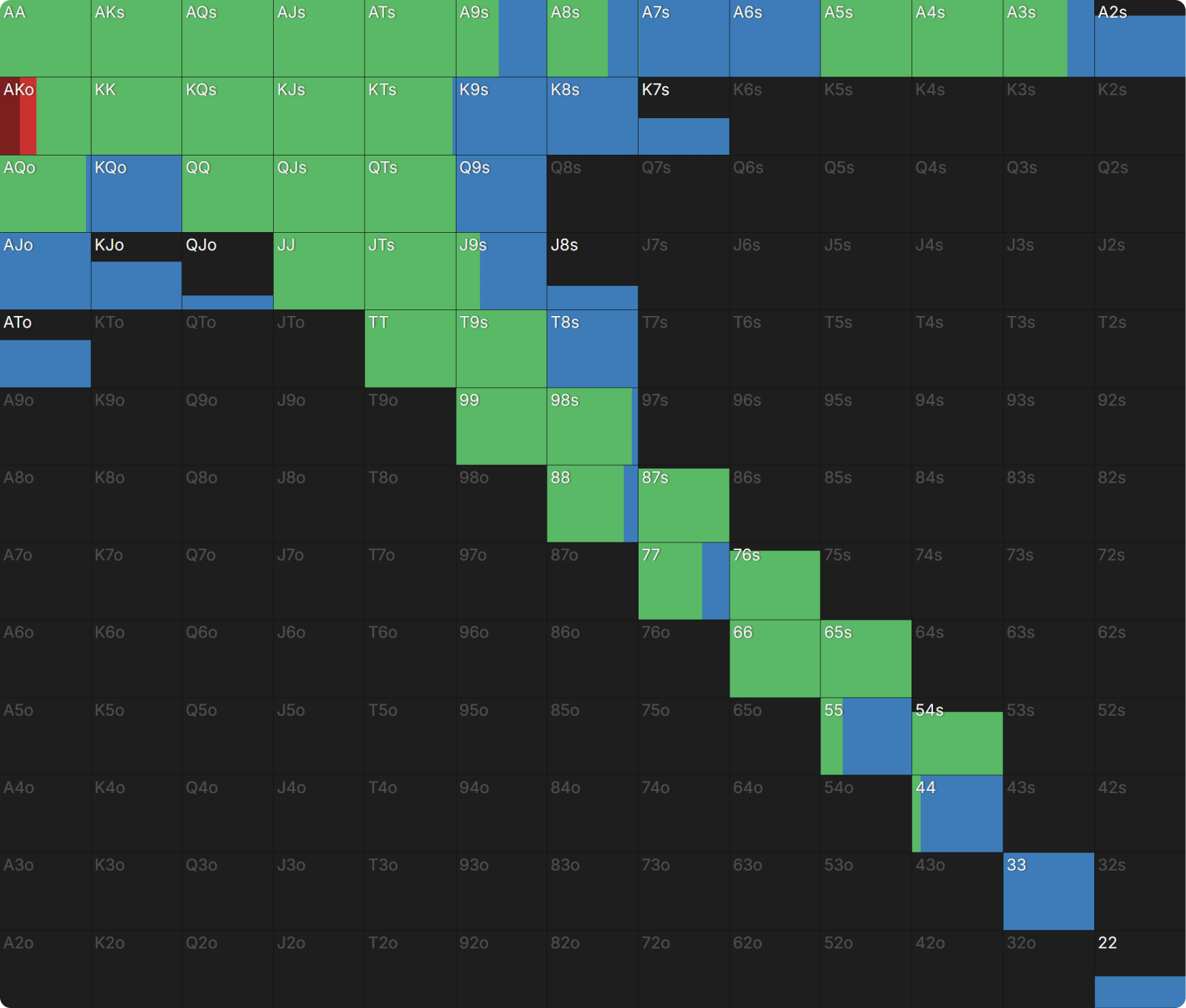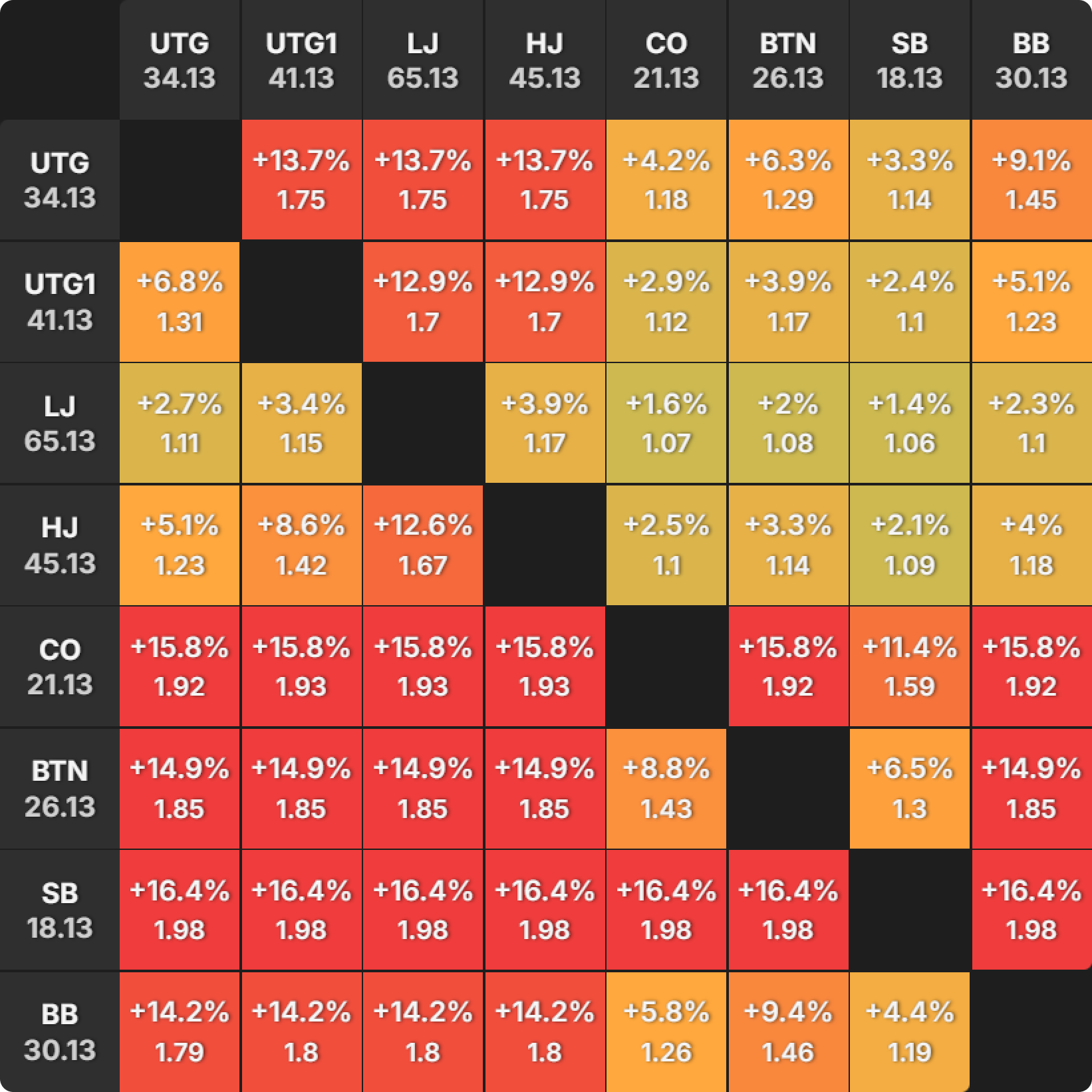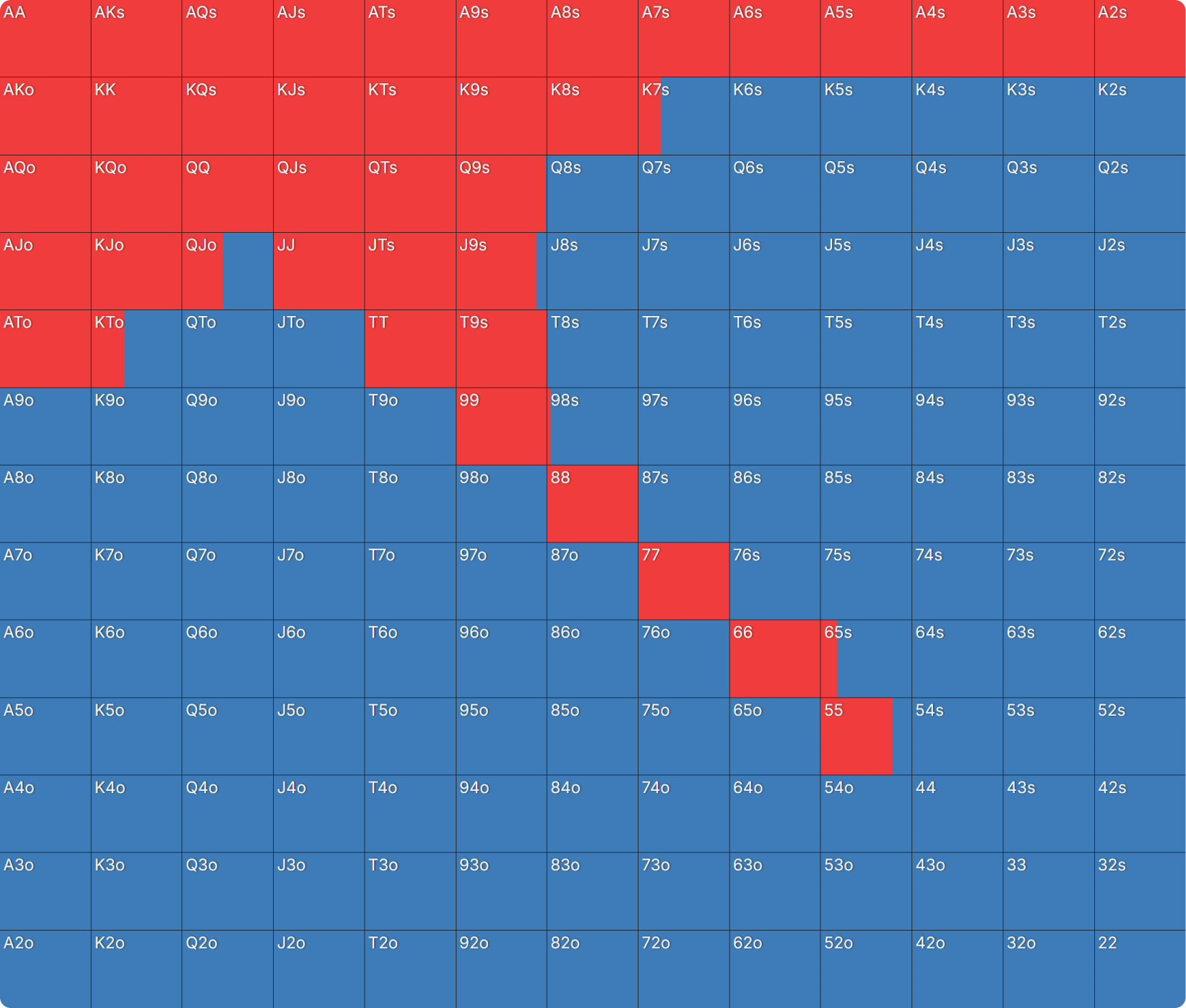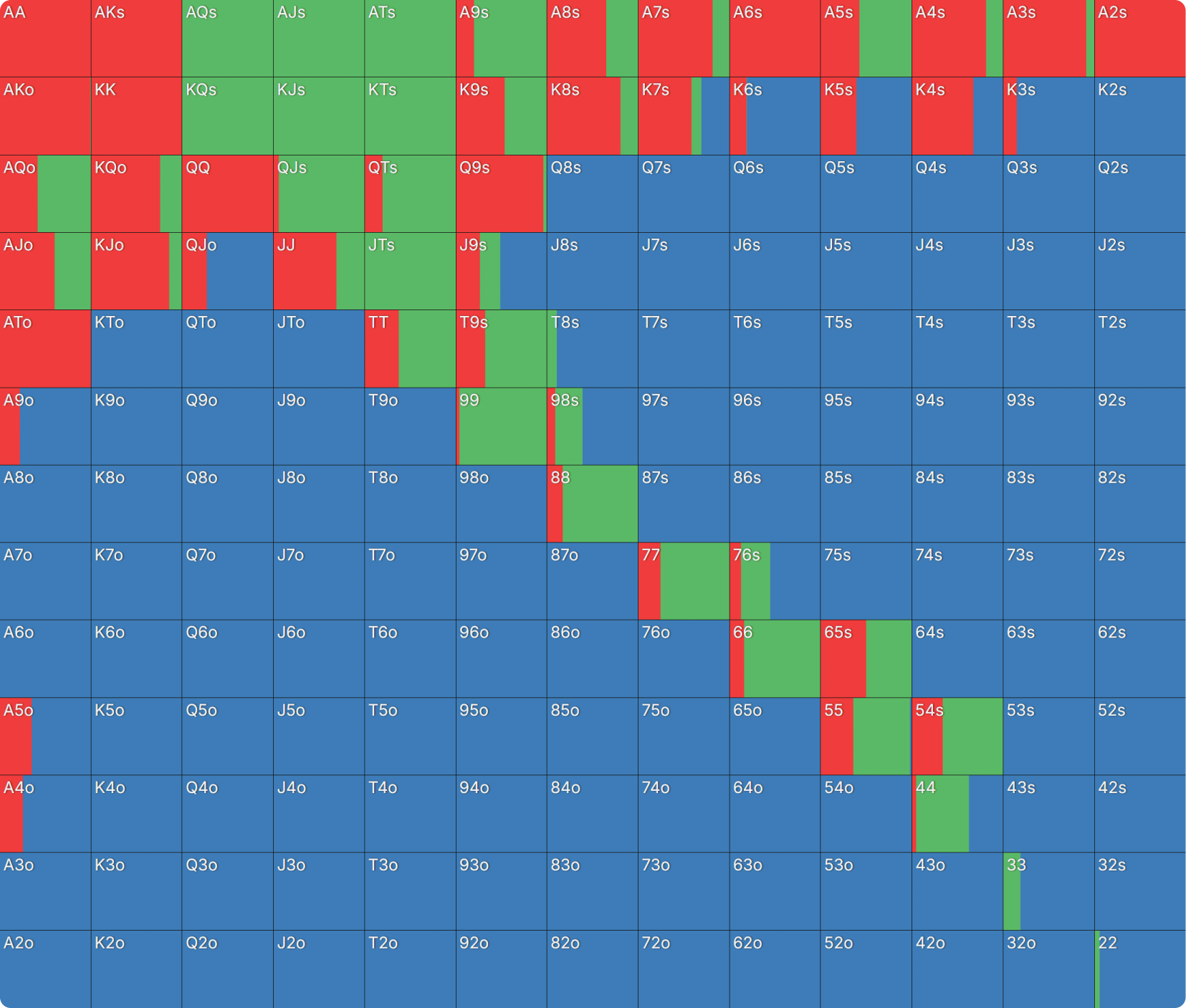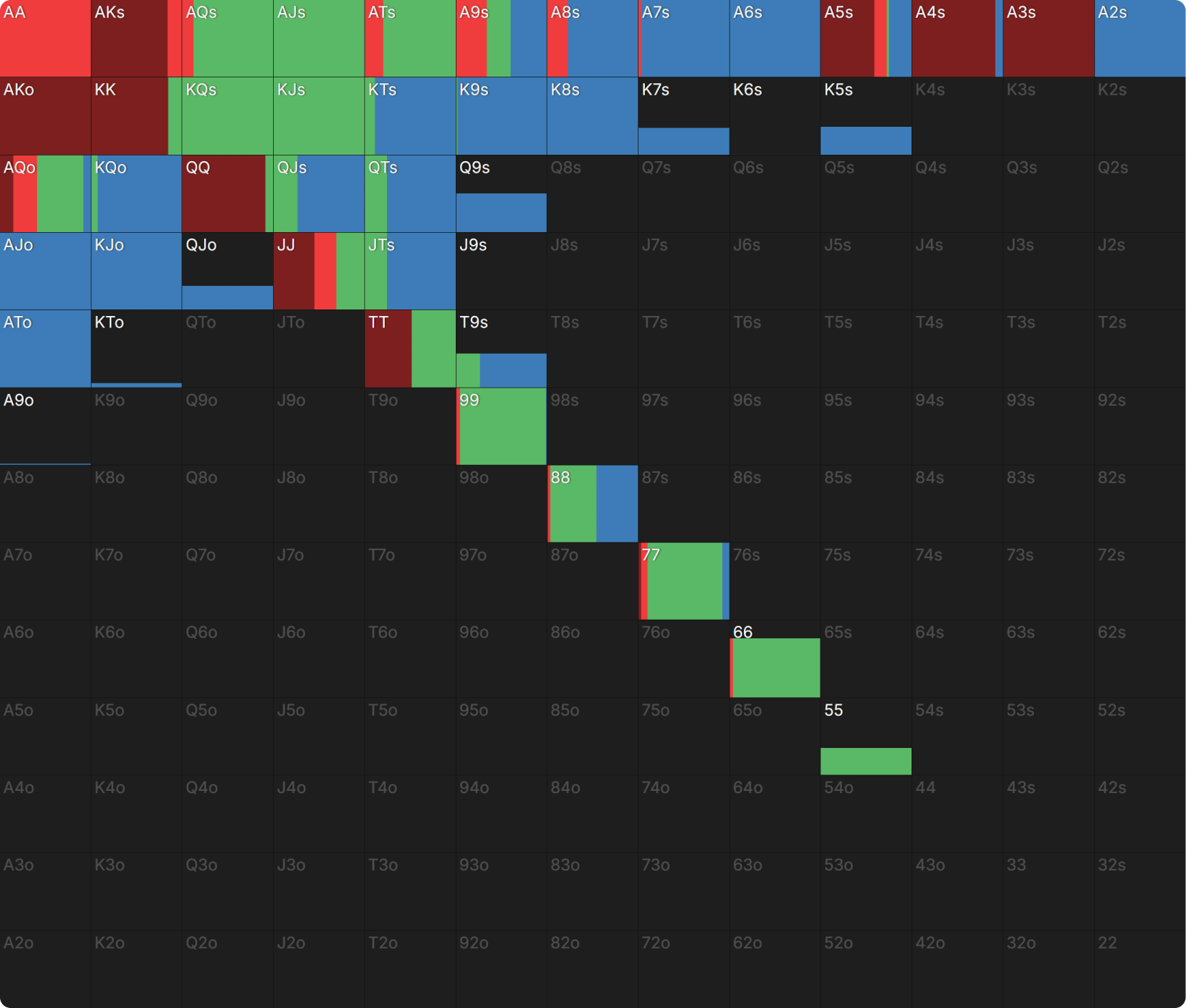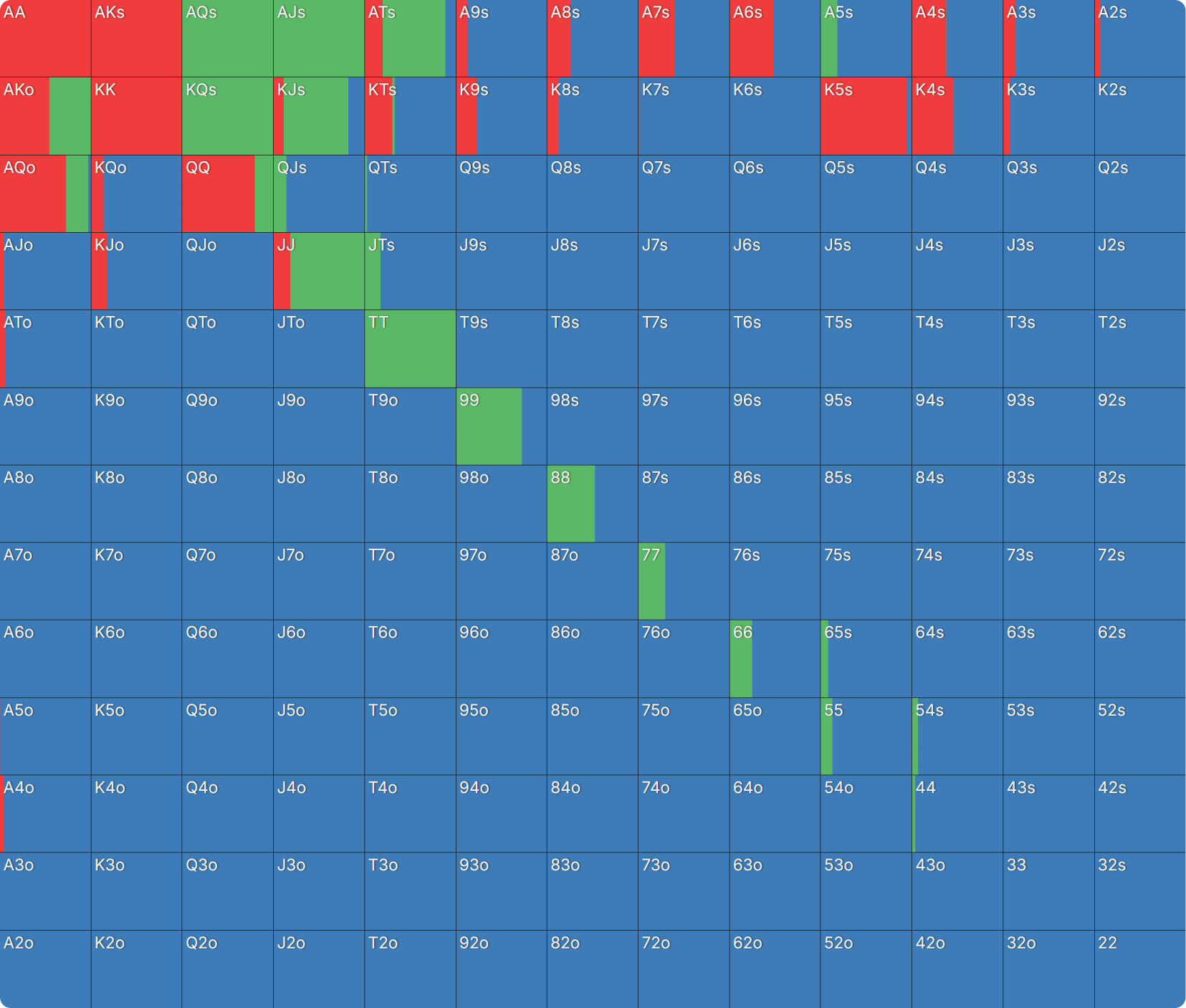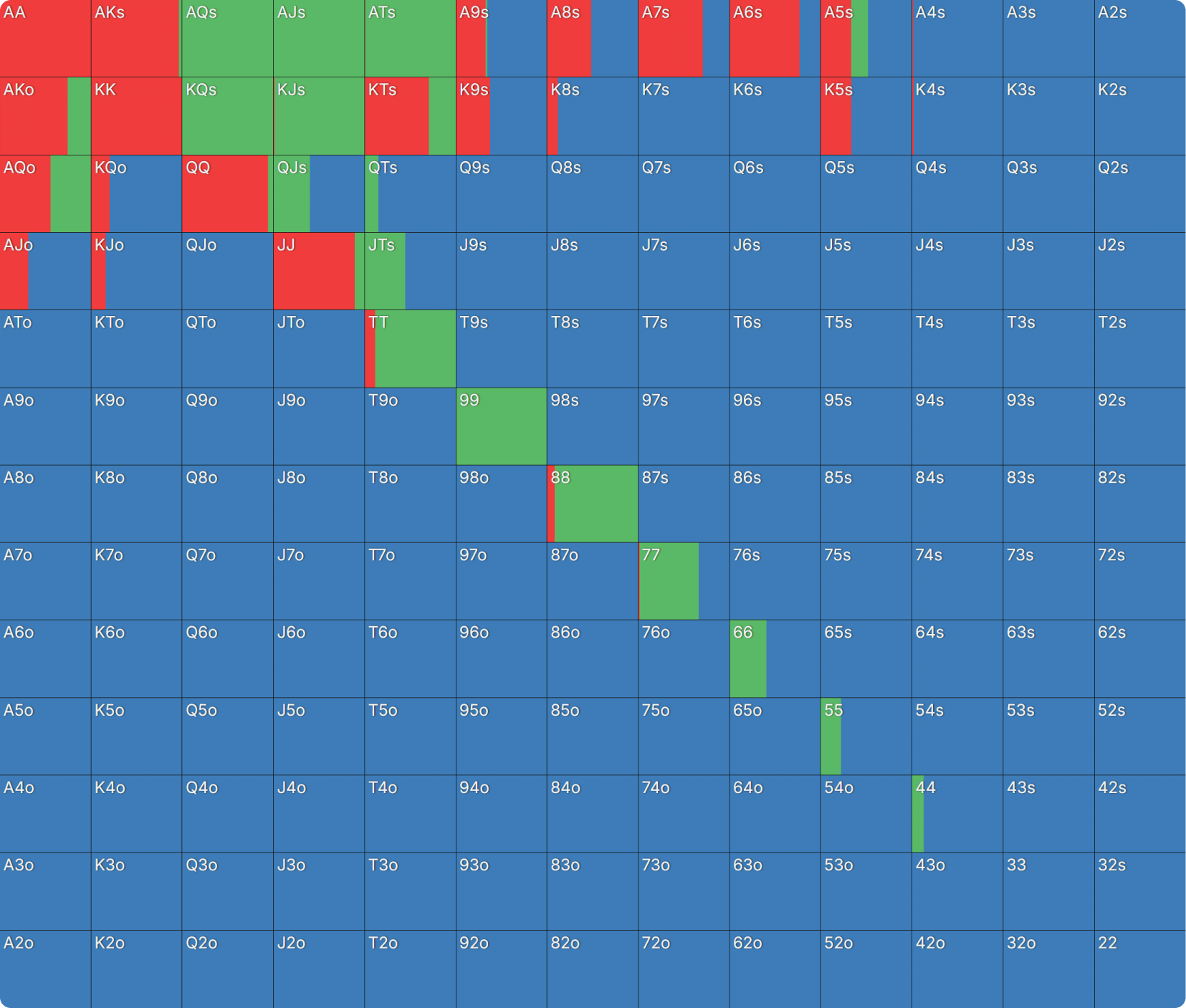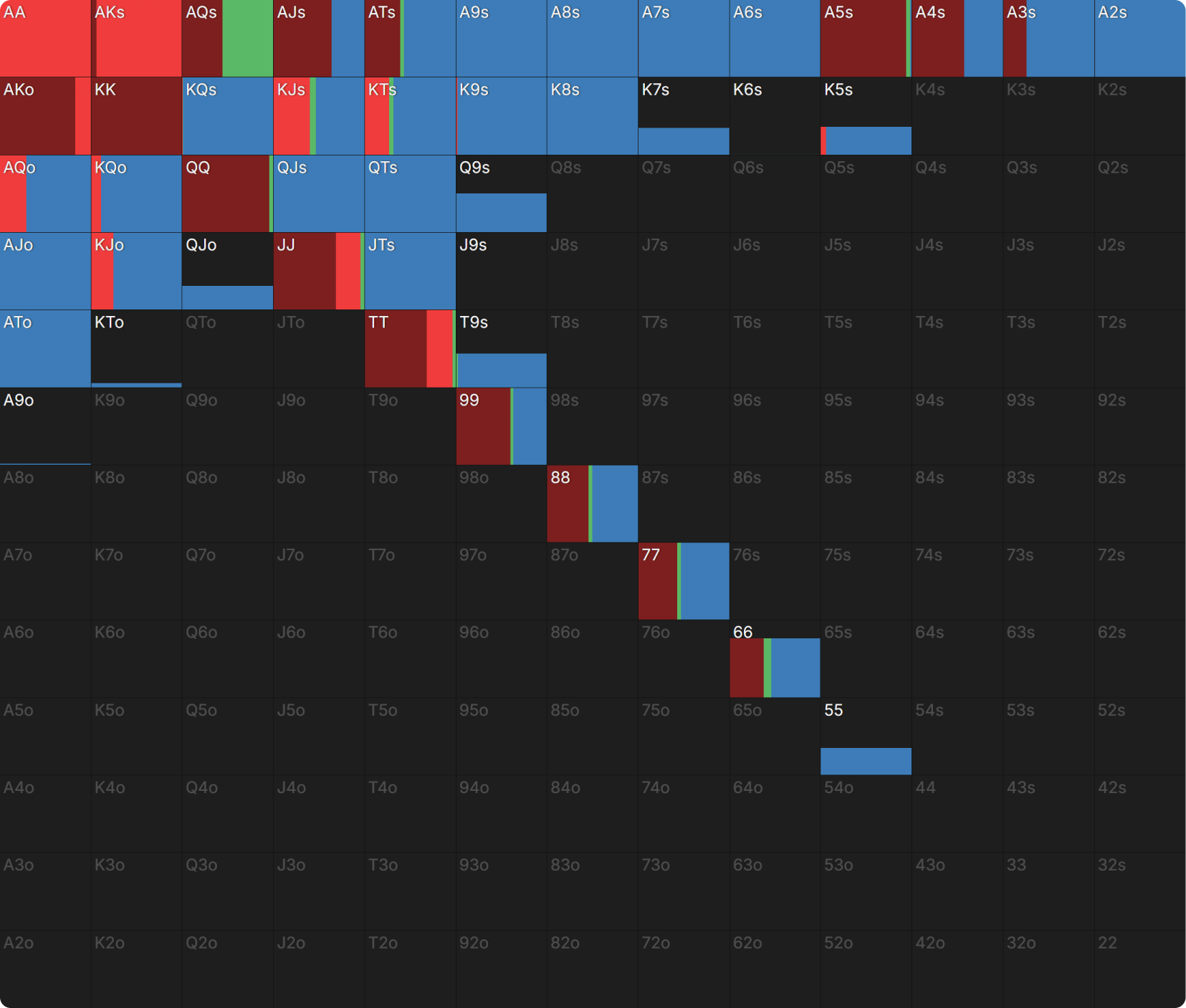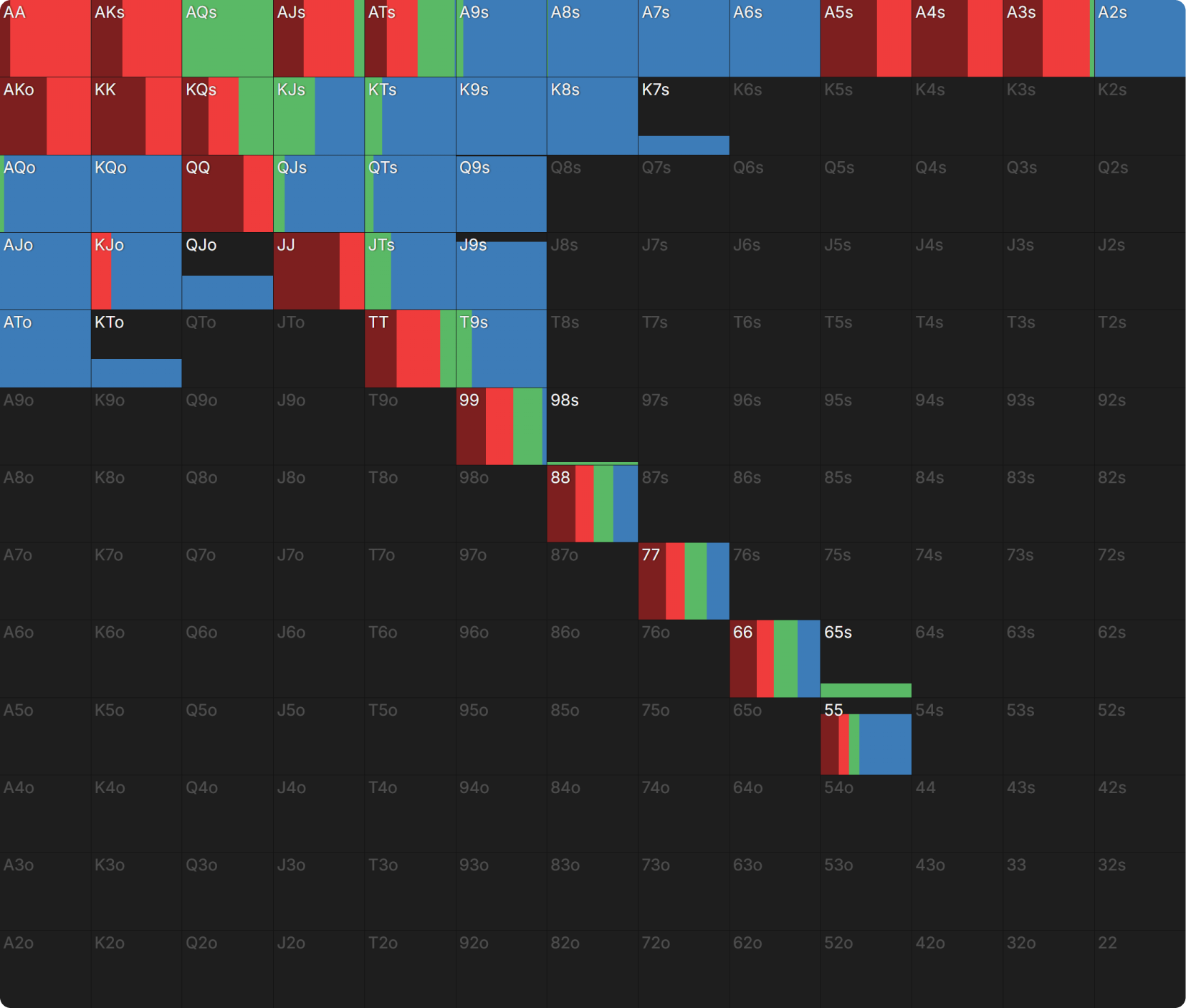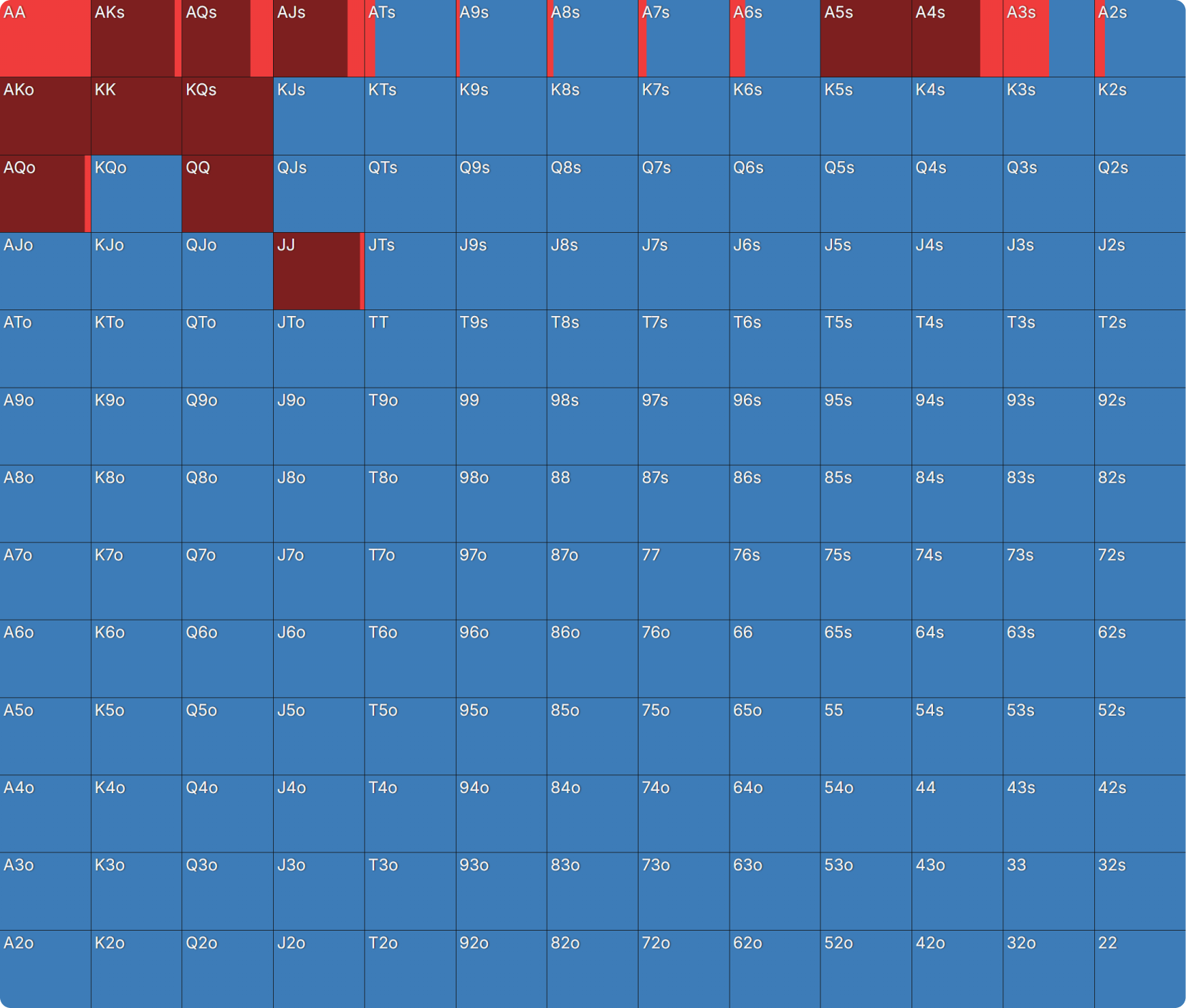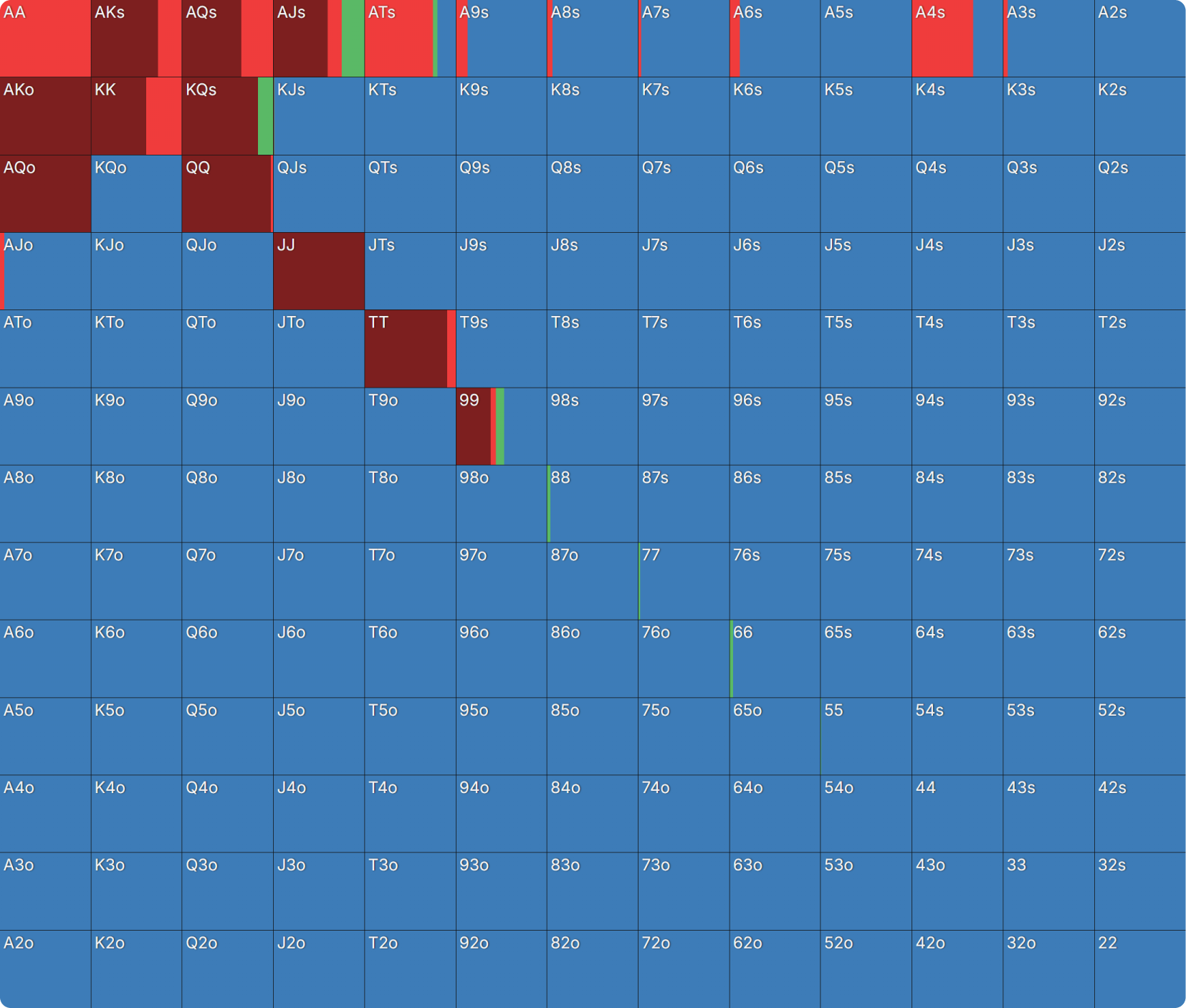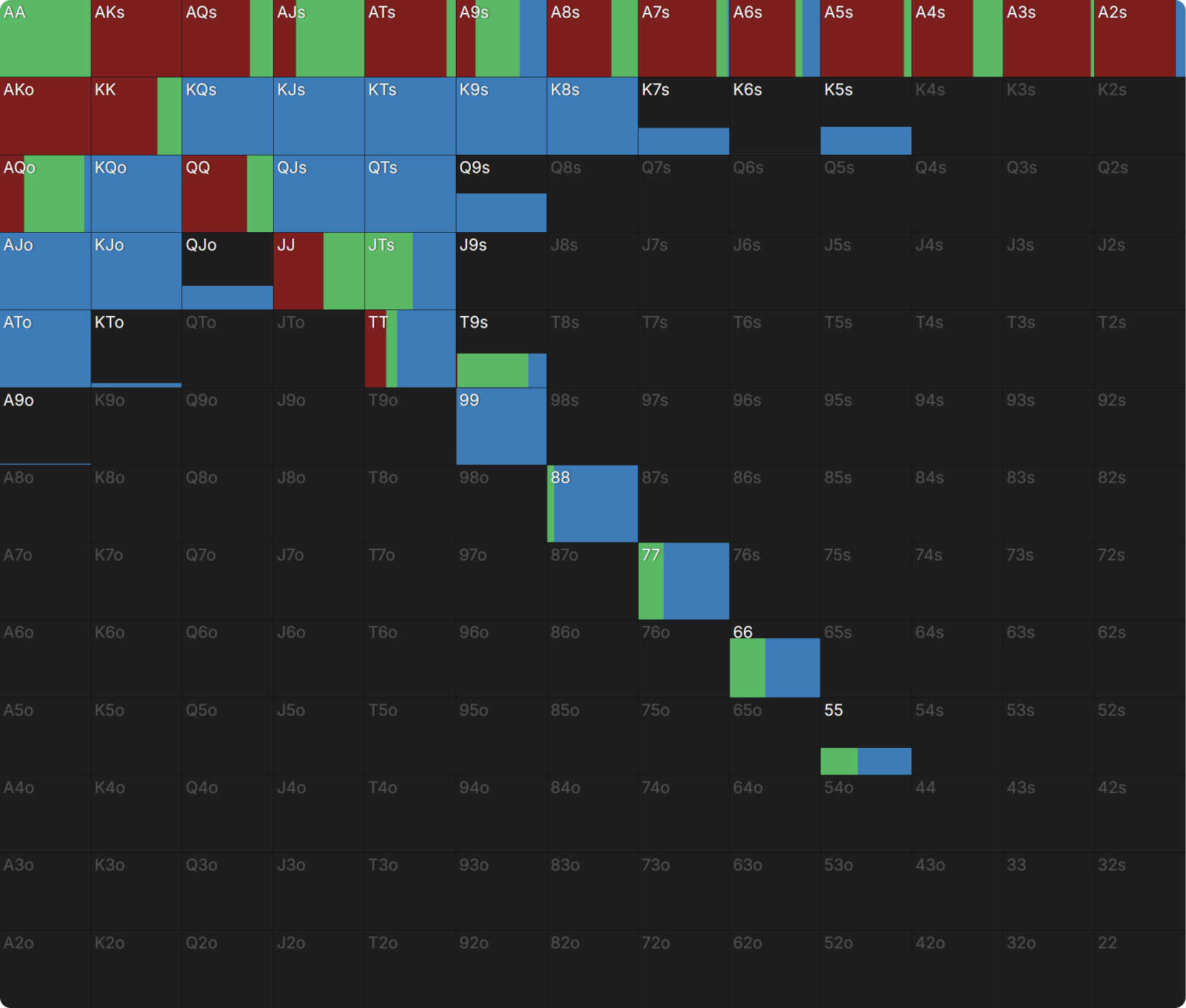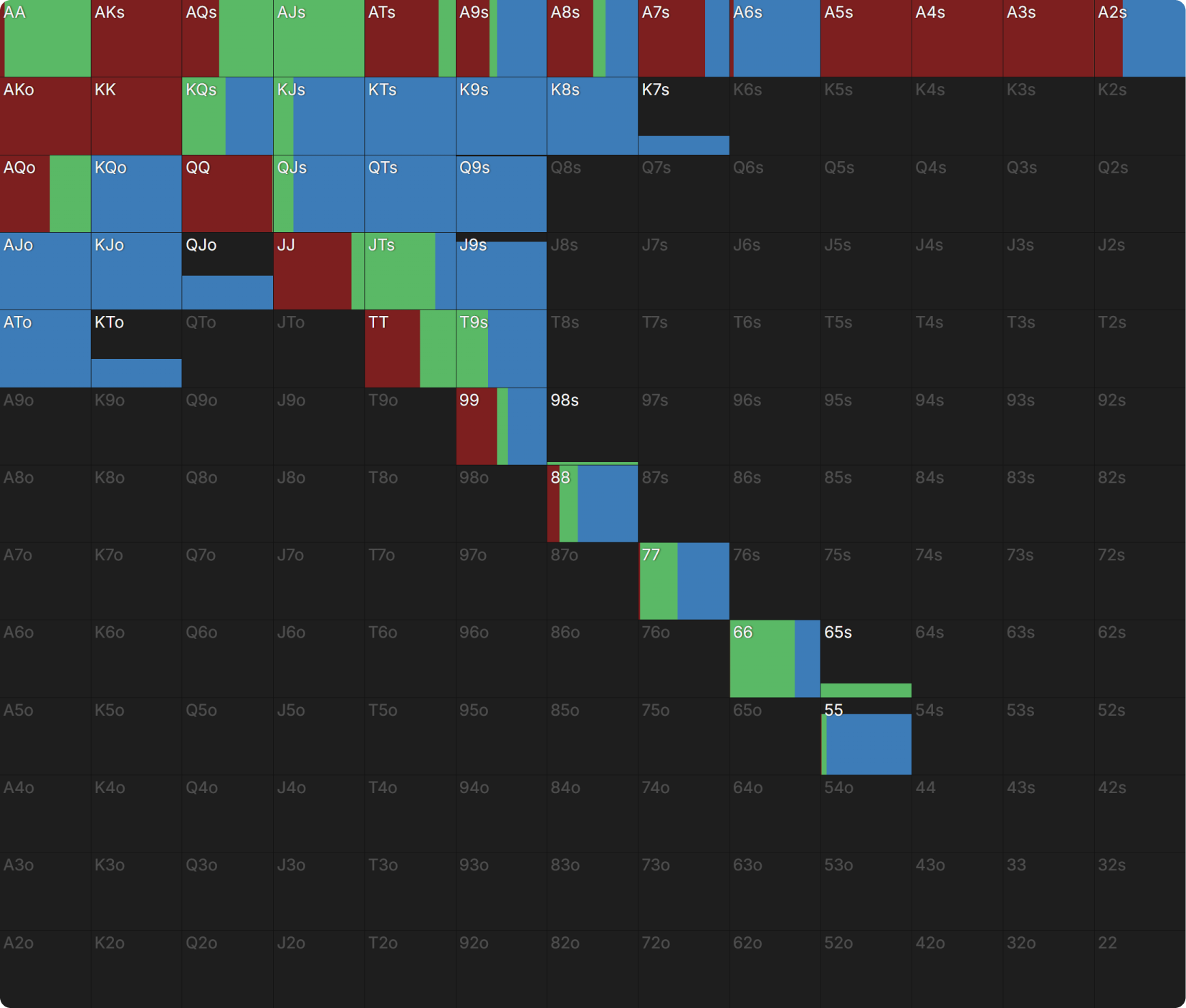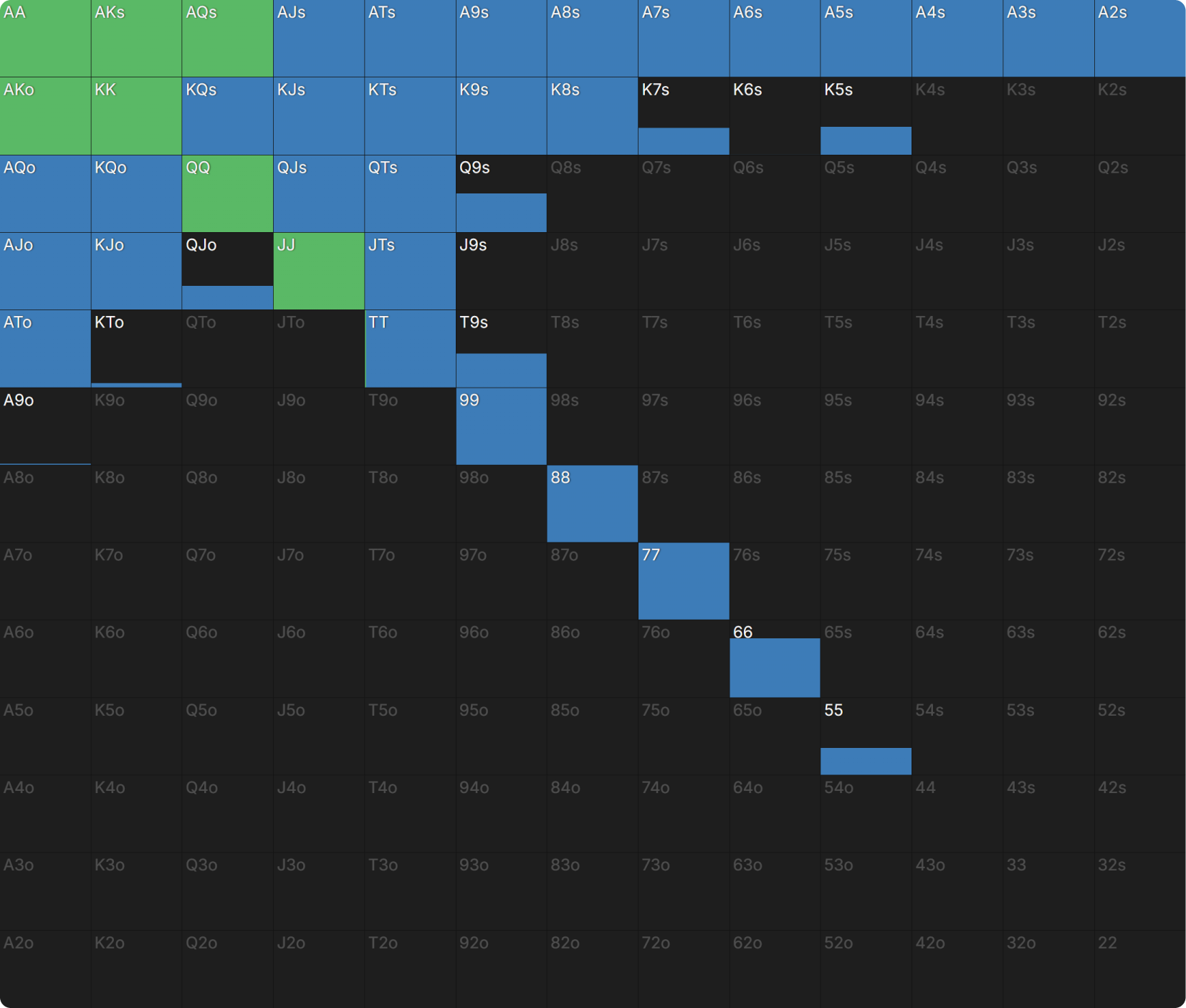PKO Versus Classic: Responding to 3-Bets
One of the keys to adapting to new game formats, such as Progressive Knockout (PKO) tournaments, is understanding when to adjust our preflop approach from that of a Classic tournament. In PKO tournaments, this begins with how we play preflop, both in the early and late stages of a tournament. Our previous articles on PKO preflop ranges covered opening ranges and how we respond to an open. Building on this knowledge, let’s look at how to handle 3-bets in a PKO versus a Classic ICM environment and how we respond based on our stack sizes.
3-Bet Frequency Review
Before we look at 3-bet responses, let’s review what we observed about PKO 3-bet frequencies in our “Responding to a Preflop Open” article (linked in the intro).
Symmetric Stack Comparisons
We’ll begin by looking at how we react to a 3-bet when playing UTG at symmetric stacks. The interactive chart below shows how each position responds to a UTG open.
We can immediately observe a few key differences in PKO responses to an open:
- In our PKO solutions at 60bb or deeper, we prefer to call significantly more often instead of folding when compared to our classic solutions. In most cases, we’re folding 25–30% less often, with some peaks up to 55% less often!
- At 30bb, our strategies tend to converge, with a 5% or less difference in each possible reaction to a 3-bet.
- Once near the bubble and facing a 3-bet at 20bb effective, we once again see more flatting or 4-betting in a PKO.
To get a better idea of why the responses to 3-bets change so drastically in some of these comparisons, let’s revisit how the risk premiumsRisk Premium
Risk Premium measures the extra risk you take stacking off in an MTT. It’s a measure of survival pressure and a valuable tool for understanding ICM spots. Risk premium is defined as the extra equity you’d need to call someone’s shove, compared to a (chip EV) pot odds calculation. RP = Required Equity (ICM) – Required Equity (cEV) when stacks are fully invested. Each player has a unique risk premium against every other player in a tournament. compare by stack depth and tournament stage.
We can see that as stacks get shallower and the tournament progresses, the difference in risk premiums becomes more pronounced.
- In the early-to-mid-stages of an MTT – The gap between PKO and Classic bubble factors is relatively static because the value of bounties versus the value of chips is practically the same.
- Near the bubble – We see that risk premiums become significantly lower for all players in a PKO as the value of each player’s bounty somewhat mitigates the risk associated with busting the tournament. For more information on this principle, known as the ‘ICM Dial,’ see our article How Does ICM Impact PKO Strategy.
Asymmetric Stacks
Now that we have seen how risk premiums impact our PKO strategy with symmetric stacks, let’s see how we adjust our postflop ranges in a PKO depending on whether we are a big, middling, or short stack.
ICM = 75% Field Left
UTG Open
Big Stack
Big Stack (CO) 3-bet vs UTG Open
First, let’s look at how CO 3-bets against this UTG opening range:
UTG Response vs Big Stack (CO) 3-bet
And here is the UTG response to this 3-bet range:
Despite being covered in the PKO solution, UTG still plays a wider call and 4-bet range. This is partly due to the lower risk premiums in PKOs and partly as a result of CO’s wider 3-bet range that allows more hands into UTG’s range. This includes calling with higher-equity hands like suited broadways and 4-betting stronger pocket pairs like JJ and QQ that perform better against the CO’s wider range at a higher frequency.
Another thing you might notice is the use of a 69.9bb 4-bet size. We will see in future articles that this committal 4-bet sizing gets used regularly in PKOs. For more information on when and how this sizing is used, see Matt Hunt’s GTO Wizard video: ‘The Fake All-in’: A New Trend in Poker Tournaments.
Mid Stack
Mid Stack (LJ) 3-bet vs UTG Open
In comparison, here’s the LJ 3-bet range:
UTG Response vs Mid Stack (LJ) 3-bet
And UTG’s response to this 3-bet:
Compared to our previous example, UTG now prefers flatting LJ’s 3-bet with a wider part of their range while 4-betting less often in a PKO. With LJ’s bounty available and a -5.6% risk premium, UTG is incentivized to see a flop with nearly their full opening range. To balance this wide flatting range, UTG now includes calls with hands as strong as AKs and KK, which would have 4-bet or jammed in a non-PKO game.
Short Stack
Short Stack (BB) 3-bet vs UTG Open
Finally, let’s take a look at BB’s response, as the shortest stack at the table, to a UTG open.
UTG Response vs Short Stack (BB) 3-bet
As the shortest stack at the table, the Big Blind’s strategy is similar between formats, 3-betting with a fairly linear range as they prefer to see a flop with a wide range. In both solutions, the UTG response is to almost pure flat with almost their full range due to BB’s 3-bet range being so top-heavy. In our PKO example, UTG has a -6.2% risk premium due to BB’s bounty being available, which leads to calling with a 9% wider range while preferring to flat AKo, versus shoving it in the classic solution. This is an example of where the covering stack prefers to accept a higher-variance line in a PKO versus in a non-PKO to have more opportunity to win a bounty postflop.
ICM = Near Bubble
UTG Open
Big Stack
Big Stack (LJ) 3-bet vs UTG Open
Again, we’ll begin with how the big stack in the LJ 3-bets against this UTG opening range.
UTG Response vs Big Stack (LJ) 3-bet
And below is UTG’s response to these 3-bets:
When covered, we see UTG use a similar strategy in both the PKO and Classic examples. They prefer to flat a 3-bet with a wider range due to their 4.3% lower risk premium. Specifically, we see additional calls from hands performing well postflop, such as suited connectors and wheel Aces.
Mid Stack
Mid Stack (BTN) 3-bet vs UTG Open
Looking at a shallower stack, here is how the Button 3-bets against UTG.
UTG Response vs Mid Stack (BTN) 3-bet
And below is UTG’s response to these 3-bets:
As the shorter stack, the Button has a similar response to UTG’s open, only incorporating JJ into their 3-bet range, while making negligible changes to their calling range. The bigger changes come from UTG’s response, where we see more calling and NAI 4-bets in the PKO example. With a 6.6% lower risk premium in the PKO, UTG is willing to play a wider range postflop.
Short Stack
Short Stack (SB) 3-bet vs UTG Open
Finally, let’s look at how the short stack in the Small Blind responds to UTG.
Here’s how UTG responds to both a non-all-in (NAI) and an all-in 3-bet from the SB.
NAI Response:
All-in Response:
Off 18bb and out of position, the Small Blind prefers a jam-or-fold strategy with nearly their full range in both solutions. The interesting difference between this and previous cases is that the PKO and classic solutions have similar strategies as the risk premiums are closer in this example. The one difference between UTG’s responses is the addition of AQo, 99, and TT in their all-in calling range due to their -2.6% risk premium in the PKO solution.
Summary
As a final step in understanding how preflop ranges change in Progressive Knockout (PKO) tournaments, we must understand how to respond to aggression when raising first in. In a PKO, the primary considerations when facing a 3-bet are how our stack relates to the 3-bettor and how we construct our flatting and 4-bet ranges. Throughout the examples above, we saw that in PKOs:
- 3-bet ranges tend to be wider due to opening ranges being wider, which influences our 4-bet and all-in strategies.
- The incorporation of non-all-in 3-bets for most of the 3-bettor’s remaining stack. For more information on when and how this sizing is used, see Matt Hunt’s GTO Wizard video: ‘The Fake All-in’: A New Trend in Poker Tournaments.
- Even in higher risk premium spots, such as near the bubble, the bounty factor in PKOs leads to wider calling ranges versus both non-all-in 3-bets and all-ins when covering.
If you want to look at how each position responds to a 3-bet across PKO and Classic ICM solutions, feel free to try out the drills linked below!
Drills
Note – All drills use High RNG.

Author
JonnyLaw
John Lawford AKA “JonnyLaw” is a mid stakes online MTT regular with a passion for the Progressive Knockout format.
Wizards, you don’t want to miss out on ‘Daily Dose of GTO,’ it’s the most valuable freeroll of the year!
We Are Hiring
We are looking for remarkable individuals to join us in our quest to build the next-generation poker training ecosystem. If you are passionate, dedicated, and driven to excel, we want to hear from you. Join us in redefining how poker is being studied.


